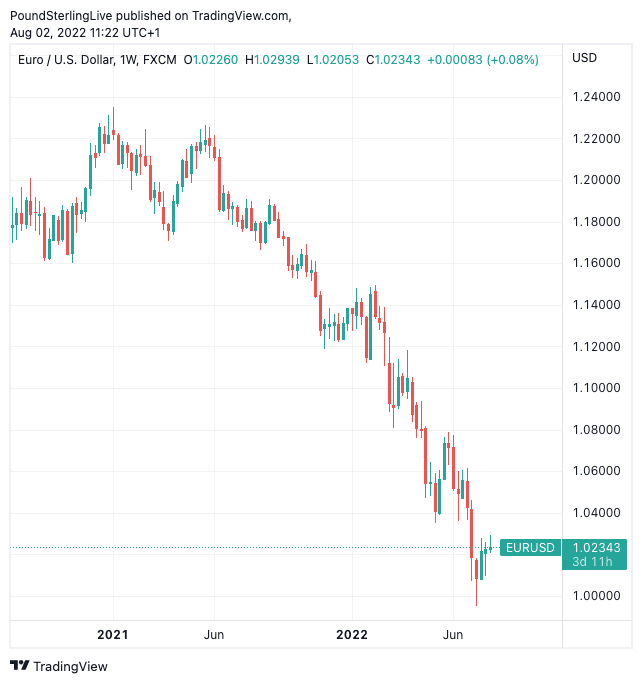GBP/EUR Rate Forecasts Upgraded at Goldman Sachs
- Written by: Gary Howes
-
- Significant hike to GBP/EUR forecasts
- As EUR set to be weighed by energy crunch
- EUR/USD to stay near parity

Image © Adobe Images
A challenging six months for the Eurozone economy will keep the Euro under pressure say analysts at Goldman Sachs who have announced a downgrade to their forecasts for the Eurozone's single currency against the Pound and Dollar.
"The next 6 months seem likely to be challenging for the Euro area, which is likely to keep EUR/USD close to parity," says Michael Cahill, foreign exchange strategist at Goldman Sachs.
Downward pressure on the headline EUR/USD will in turn weigh on the single-currency against the British Pound.
The call comes alongside predictions by Goldman Sachs' economists for the Eurozone economy to fall into recession in the second half of the year.
"The recent move lower in EUR/USD reflects this shifting growth outlook, and is likely to extend somewhat further," says Cahill. The Euro to Dollar exchange rate (EUR/USD) has been in decline since May 2021 where it peaked at 1.2254:
Above: EUR/USD at weekly intervals, highlighting the EUR's decline.
The pair has trended lower steadily since, reaching a nadir at 0.9952 in July 2022 before recovering somewhat to 1.0233 where we find it today.
"The recent recovery in EUR/USD is not entirely justified by the news flow and the market still has some work to do to price our new baseline outlook," says Cahill.
The Euro to Pound exchange rate has meanwhile traded in a broad sideways pattern since June 2016, but it is now testing the bottom of this range:
Above: EUR/GBP at monthly intervals, showing EUR nearing bottom of the range.
A list of fundamental drivers are widely acknowledged to be driving the decline in Euro exchange rates over recent months.
The European Central Bank's reticence to raise interest rates despite increasing inflation rates has meant the yield paid on U.S. and UK government gilts and other monetary assets is significantly higher than that paid to investors holding equivalent Eurozone assets.
Although the ECB has raised interest rates, the differential with the U.S. and UK remains stark.
The most recent leg of Euro weakness was triggered by the war in Ukraine and associated energy price surge which has heavily impacted the Eurozone's economic output potential and consumer health.
"With natural gas supplies from Russia well below normal, it will require some form of demand destruction," says Cahill.
Economists at the Wall Street bank say demand for energy must be curtailed significantly through some combination of higher prices and government policies if the Eurozone is to make it through the winter, even if storage tanks are full.
Goldman Sachs' commodity strategists have meanwhile warned weather-related uncertainty will be particularly elevated in the first half of winter.
Symptomatic of the energy challenges facing the Eurozone was the surge in Germany 1-year forward baseload electricity prices on Tuesday, August 02.
Prices surged to over €400 per MWh for the first time ever.
"We are truly into crunching territory for the country's energy-intensive manufacturing industry," said Javier Blas, energy and commodities columnist at Bloomberg.
For context, the current price is ~1,000% higher than the €41.1 per MWh 2010-2020 average.
"As a result, we are revising down our 3m and 6m EUR/USD forecast to 0.99 and 1.02 (from 1.05 and 1.10 previously)," says Cahill.
Euro-Pound forecasts are downgraded to 0.83 and 0.84, from 0.88 and 0.90 previously. (Set your FX rate alert here).
This gives a Pound to Euro forecast upgrade to 1.2050 in three months and 1.19 in six months, from 1.1364 and 1.11 previously.












